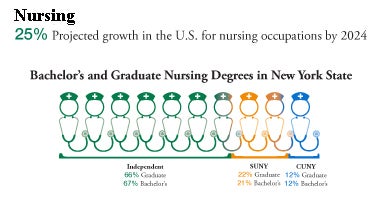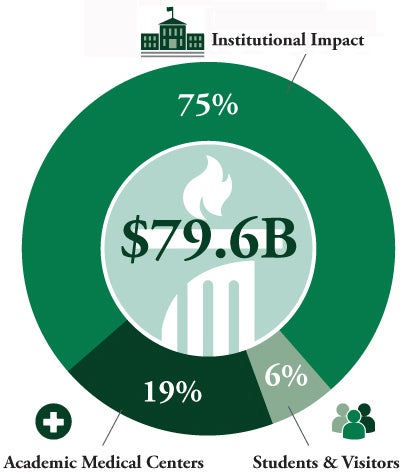As high school seniors in New York state embark on their autumn college tours, parents in tow, it’s important to note that the state’s independent colleges and universities, 90 of which awarded bachelor’s degrees in 2015-16, provide a great deal of lifetime value to students and families. This is especially pertinent as free tuition is offered to certain low- to middle-income families through the state’s Excelsior Scholarship program.
With smaller class sizes (20 on average), meaningful engagement with faculty and mentors, real-world opportunities, smaller student bodies (60 percent of independent, not-for-profit colleges and universities in NYS enroll fewer than 2,000 students) and comparatively positive outcomes (high graduation rates and excellent employment statistics), the relative cost of going to a private college or university is favorable to families.
The independent sector led degree completion in New York with a 70.1 percent six-year graduation rate in 2015, up from 59.7 percent in 2000. The independents outpace other sectors in the production of degrees in today’s all-important (and high-paying) STEM fields (science, technology, engineering, and mathematics). In 2015, the independents awarded 56 percent of the state’s bachelor’s degrees, and 71 percent of graduate degrees earned in STEM. Particularly strong are the fields of nursing and the biomedical sciences.
At Niagara University, 97 percent of graduates were offered full-time employment (or were enrolled in graduate school) within six months of graduation. Approximately 26 percent pursue advanced degrees upon graduation.
The average cost of attending an independent college or university is not much higher – in most cases – than attending a state school. The Tuition Assistance Program (TAP) helps more than 370,000 students pay their tuition at a New York state college or university. In 2014-15, students at independent colleges and universities received $220 million in TAP funds. In addition, nearly 113,000 received Pell Grants totaling $474 million, approximately 25 percent of the Pell dollars awarded in New York state. More than 47,000 students received Federal Supplemental Education Opportunity Grants (FSEOG), totaling $28 million, which represents 54 percent of the FSEOG dollars awarded in New York. With institutional aid totaling $5.4 billion, students are attending with a sizable portion of their tuition supplemented.
And let’s not forget the economic impact of independent sector colleges and universities on the state’s economy, which helps all of its citizens. The independent sector’s total economic impact in New York is $79.6 billion. These schools employ 406,300 people (179,700 at the institutions themselves, 210,000 in indirect jobs and 16,600 in construction). The total payroll from these institutions is $28.1 billion, with a tax contribution of $2 billion.
As high school students and their families investigate colleges and universities in New York state this fall, it’s important that they consider all colleges and universities and look into the value they offer. Considering a college or university by cost alone is not the only way to find worth, especially when contemplating long-term outcomes. The decision to attend the right college or university can mean the difference in lifetime earnings in excess of $1 million. That, coupled with the intangible aspects of attending the right college or university for an individual can make an extraordinary difference in one’s life. As with most major life investments, it is more important to find the best long-term value for your dollar than it is to make decisions on sticker price alone. Where you go to college is about more than what you spend. It is about time, engagement and success in college. It is about learning with faculty, under the mentorship and guidance of a community that knows and cares about its students.


